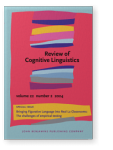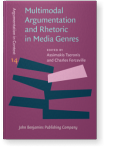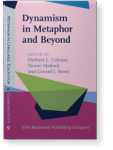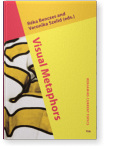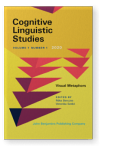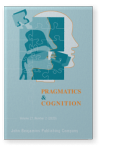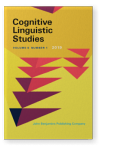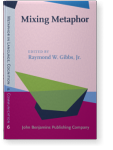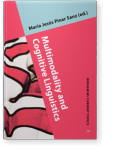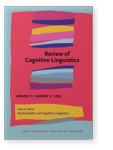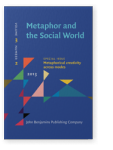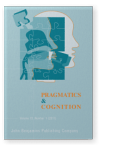Charles Forceville
List of John Benjamins publications for which Charles Forceville plays a role.
Journal
Book series
Title
Multimodal Argumentation and Rhetoric in Media Genres
Edited by Assimakis Tseronis and Charles Forceville
[Argumentation in Context, 14] 2017. ix, 301 pp.
Subjects Communication Studies | Discourse studies | Pragmatics
2023 Narrating and focalizing visually and visual-verbally in comics and graphic novels Pragmatics & Cognition 30:1, pp. 180–208 | Article
Literary narratology has rightly devoted much attention to analysing the source(s) of verbal information about the story world, usually discussed under the label “narration”, and to any agent(s) that present(s) non-verbalized perspectives on it, usually discussed under the label “focalization”.… read more
2022 Relevance theory perspectives on web-mediated communication Dynamism in Metaphor and Beyond, Colston, Herbert L., Teenie Matlock and Gerard J. Steen (eds.), pp. 325–340 | Chapter
Cognitivist approaches are in need of an inclusive theory of communication. Relevance theory (RT) is well-equipped to develop into such a theory, but to fulfill its promise it should be able to accommodate digital-platform-based exchanges. Since communication via digital platforms often takes… read more
2022 Visual and multimodal interaction of metaphor and metonymy: A study of Iranian and Dutch print advertisements Visual Metaphors, Benczes, Réka and Veronika Szelid (eds.), pp. 83–116 | Chapter
Conceptual Metaphor Theory’s central idea that metaphor is a figure of thought rather than a figure of language has led to the examination of nonverbal and multimodal manifestations of metaphor. Over the past twenty years, the verbal trope of metonymy has similarly been theorized from a… read more
2020 Visual and multimodal interaction of metaphor and metonymy: A study of Iranian and Dutch print advertisements Visual Metaphors, Benczes, Réka and Veronika Szelid (eds.), pp. 78–110 | Article
Conceptual Metaphor Theory’s central idea that metaphor is a figure of thought rather than a figure of language has led to the examination of non-verbal and multimodal manifestations of metaphor. Over the past twenty years, the verbal trope of metonymy has similarly been theorized from a… read more
2020 Metaphor and metonymy in Chinese and American political cartoons (2018–2019) about the Sino-US trade conflict Pragmatics & Cognition 27:2, pp. 474–499 | Article
Political cartoons make meaning by drawing on scenarios that must be immediately recognizable by their intended audience. Crucial meaning-making mechanisms in these scenarios are verbo-visual ensembles of metaphors and metonymies. In this paper we investigate 69 Chinese and 60 American political… read more
2019 Andreas Musolff (2016), Political Metaphor Analysis: Discourse and Scenarios Cognitive Linguistic Studies 6:1, pp. 210–214 | Review
2017 From metaphor to allegory: The Japanese manga Afuganisu-tan Metaphor and the Social World 7:2, pp. 235–251 | Article
Afuganisu-tan is an online manga by Timaking, published in English online in 2005, that presents selected historical events of modern Afghanistan in a series of 29 episodes plus an appendix. An episode consists of a four-panel micro-narrative in which Afghanistan and the countries with which… read more
2017 Introduction. Argumentation and rhetoric in visual and multimodal communication Multimodal Argumentation and Rhetoric in Media Genres, Tseronis, Assimakis and Charles Forceville (eds.), pp. 1–24 | Chapter
2017 Chapter 6. The argumentative relevance of visual and multimodal antithesis in Frederick Wiseman’s documentaries Multimodal Argumentation and Rhetoric in Media Genres, Tseronis, Assimakis and Charles Forceville (eds.), pp. 165–188 | Chapter
In this chapter we argue that certain salient contrasts that Frederick Wiseman presents non-verbally and multimodally in his Direct Cinema documentaries can be understood as antitheses that play an argumentative role. In this type of documentary, which renounces the use of voice-over narration and… read more
2016 Chapter 11. Mixing in pictorial and multimodal metaphors? Mixing Metaphor, Gibbs, Jr., Raymond W. (ed.), pp. 223–240 | Article
“Mixed metaphors” in language use two or more different source domains to predicate something about the same target domain in a short stretch of discourse. This often leads to unintendedly humorous results and is usually considered bad style. Given that metaphors may be expressed pictorially or… read more
2015 Metaphor and symbol: SEARCHING FOR ONE’S IDENTITY IS LOOKING FOR A HOME in animation film Multimodality and Cognitive Linguistics, Pinar Sanz, María Jesús (ed.), pp. 27–44 | Article
The quickly growing discipline of multimodality has hitherto primarily found its inspirational models in semiotics and in Systemic Functional Linguistics. However, Cognitive Linguistics, and specifically its Conceptual Metaphor
Theory branch, has over the past years proved a store of knowledge and… read more
2013 Metaphor and symbol: SEARCHING FOR ONE’S IDENTITY IS LOOKING FOR A HOME in animation film Multimodality and Cognitive Linguistics, Pinar Sanz, María Jesús (ed.), pp. 250–268 | Article
The quickly growing discipline of multimodality has hitherto primarily found its inspirational models in semiotics and in Systemic Functional Linguistics. However, Cognitive Linguistics, and specifically its Conceptual Metaphor Theory branch, has over the past years proved a store of knowledge and… read more
2013 The GOOD IS LIGHT and BAD IS DARK metaphor in feature films Metaphorical creativity across modes, Hidalgo-Downing, Laura and Blanca Kraljevic Mujic (eds.), pp. 160–179 | Article
Light and darkness can be used metaphorically to help structure good and bad in all media, but film is particularly suitable for exploiting such metaphors. On the basis of examples from three feature films, we discuss in what way the metaphor functions in general and suggest how it allows for a… read more
2013 LIFE IS A JOURNEY: Source–path–goal structure in the videogames “Half-Life 2”, “Heavy Rain”, and “Grim Fandango” Metaphor and the Social World 3:1, pp. 100–116 | Article
The debate between narrativists and ludologists has long enlivened discussions among game theorists. Should videogames be seen as an offshoot of (film) stories, and thus be studied primarily from the perspective of narratology? Or do they represent a truly different phenomenon, and thus require an… read more
2011 The flesh and blood of embodied understanding: The Source-Path-Goal schema in animation film Pragmatics & Cognition 19:1, pp. 37–59 | Article
According to Conceptual Metaphor Theory (CMT), the Source-Path-Goal (SPG) schema constitutes a central concept in cognition. Apart from literally structuring “movement”, SPG also shapes our understanding of “purposive activity”, including questing and story-telling. A problem in CMT, however, is… read more
2003 Review of Engelhardt (2002): Document Design 4:3, pp. 287–290 | Review
